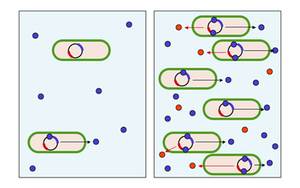Quorum sensing
| Parent |
| Cell number homeostasis in free-living populations |
| Subordinate |
| Interspecies QA Intraspecies QA |
| Gene Ontology |
|---|
| QuickGO |
As quorum sensing , the ability is protozoa called about chemical communication , the cell density of the population to measure. It allows the cells in a suspension to activate certain genes only when a certain cell density is exceeded or not reached. As such, the term “ quorum ” comes from the time of the Roman Empire and referred to the smallest number of members required for a vote in the Senate.
The American professor Bonnie L. Bassler played a key role in researching quorum sensing in the 1990s . The term was coined by Fuqua, Winans and Greenberg .
Quorum sensing is used by bacteria to coordinate processes that would be inefficient if only carried out by individual cells, e.g. B. bioluminescence , the formation of biofilms or the secretion of antibiotics or pathogenicity factors .
Bacteria that use quorum sensing produce and secrete signal molecules that act as autoinducers or pheromones . In the case of Autoinducer-1 (AI-1), this is N- acyl-homoserine-lactone (AHL). AI-1 is used for intra-species communication. Autoinducer -2 is a cyclic furanosyl borate diester and is used for communication between different types of bacteria. The nature of the Autoinducer-3 is unknown. He will u. a. used by enterohaemorrhagic Escherichia coli .
Autoinducers are continuously released into the medium or can easily pass through cell membranes because they are amphiphilic . When the concentration exceeds a threshold value, autoinduction begins via a specific receptor and various genes are activated, including those that produce the autoinducer: positive feedback sets in, which leads to complete activation of the receptor, which in turn causes the Regulation of other genes (in the picture on the right). For example, the luciferase responsible for bioluminescence is induced in this way.
Quorum sensing coordinates the behavior of the bacteria of a species in a small space. Pseudomonas aeruginosa , a causative agent of pneumonia and other infections , can live within its host without harming it. However, if it multiplies strongly, it changes its "behavior": the cells form biofilms and can lead to the host becoming ill.
The first organisms in which quorum sensing was observed are the complex myxobacteria and species from the genus Streptomycetes . The best known, however, is the bioluminescence of Vibrio fischeri , a bacterial species that lives as a symbiont in the luminous organs of a sepia species . Free-living bacteria of this type do not reach the same concentration as within these organs, which is why they do not glow there.
Streptococcus pneumoniae uses quorum sensing to achieve competence .
Farnesol acts as a quorum sensing molecule in the dimorphic fungus Candida albicans . It inhibits hyphae growth in high population densities.
literature
- Waters, CM & Bassler, BL (2005) Quorum sensing: cell-to-cell communication in bacteria. In: Annu. Rev. Cell. Dev. Biol. Vol. 21, pp. 319-346. PMID 16212498 doi: 10.1146 / annurev.cellbio.21.012704.131001 PDF
- Kay, E. et al. (2006): Small RNAs in Bacterial Cell-Cell Communication. In: Microbe. Vol. 1, pp. 63-69. PDF
- Sun, J. et al. (2004): Is autoinducer-2 a universal signal for interspecies communication: a comparative genomic and phylogenetic analysis of the synthesis and signal transduction pathways. In: BMC Evol. Biol. Vol. 4, p. 36. PMID 15456522 doi: 10.1186 / 1471-2148-4-36 PDF
- Jasmine Lee, Jien Wu, et al. a .: A cell-cell communication signal integrates quorum sensing and stress response. In: Nature Chemical Biology. 9, 2013, pp. 339-343, doi: 10.1038 / nchembio.1225 .
Individual evidence
- ^ WC Fuqua, SC Winans, EP Greenberg: Quorum sensing in bacteria: the LuxR-LuxI family of cell density-responsive transcriptional regulators. In: Journal of bacteriology. Volume 176, Number 2, January 1994, ISSN 0021-9193 , pp. 269-275, PMID 8288518 , PMC 205046 (free full text) (review).
